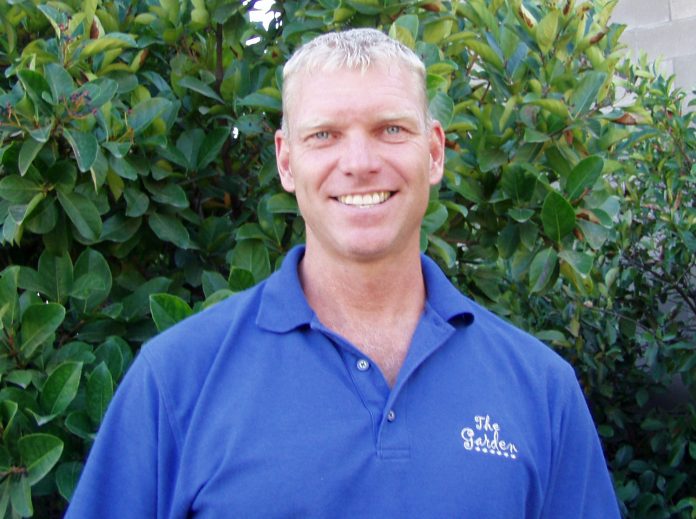The enormous pipe at The Water Conservation Garden told a tale that’s become familiar in the area for most of the last eight years. The trickle at its base signaled a return to drought conditions (the recent trace of rain notwithstanding), with the National Integrated Drought Information System website reflecting a “severe” rainfall deficiency through San Diego County and points north as of Sept. 25.
The enormous pipe at The Water Conservation Garden told a tale that’s become familiar in the area for most of the last eight years. The trickle at its base signaled a return to drought conditions (the recent trace of rain notwithstanding), with the National Integrated Drought Information System website reflecting a “severe” rainfall deficiency through San Diego County and points north as of Sept. 25.
The state issued an all-clear during the spring of 2017 amid heavy winter precipitation; the return to rainlessness has now affected some 34 million people, or 93 percent of the state population, with the most exceptional conditions touching the extreme Southeast.
So begins another day at The Garden, El Cajon’s active nod to the preservation of the world’s most vital resource. It is designed to reflect an ideal partnership between area plant life and the personnel that tend it — coastal oaks, California lilacs, sage, yucca and plant and vegetable gardens sprawl among and around irrigation exhibits and mulch at 12122 Cuyamaca College Drive West, and they represent more than a decorative element in East County life.
“We’re a learning center,” according to a published report on Paul Redeker, The Garden’s director of horticulture and facilities. “[This is] not just a place where you’re surrounded by beautiful plants. All of our exhibits are geared toward teaching. We are all about educating the public to be inspired to make changes in their lives, because we’re literally at the end of the (Colorado River) pipeline,” from which this area receives most of its water.
Indeed, we are, in more ways than one.
According to a National Geographic survey, drinkable water makes up a fraction of the world’s supply. Although 70 percent of the earth’s surface is covered by water, only 2.5 percent of it is fresh. The rest is saline- and ocean-based. And just one percent of the fresh water is accessible, with much of it trapped in glaciers and snow.
Enter The Garden, opened to the public in 1999 following a series of droughts amid the region’s paltry ten inches of annual precipitation. The Garden’s annual budget is $1.5 million, mined through memberships, donations, contracts, grants and support from several area water districts.
In 2005, the nonprofit Friends of the Water Conservation Garden was created to increase private support. The group assumed governance of The Garden six years later.
The Garden, which welcomed more than 34,000 visitors in 2017, also serves as an outdoor classroom at Cuyamaca College, wherein students can survey the plants, shrubs and trees they will be using in their future professions.
“The continued availability of classes geared toward basic methods and tools for efficient water use,” Redeker said, “is important to residents new to the area and new to water-smart landscaping. In addition, as research and improved conservation methods and technologies emerge, The Garden incorporates them into program offerings to the community.”
Accordingly, some 14 programs, including four to six classes a month for the general public, are geared toward these advances.
An exhibit featuring pavement that allows water to permeate to the soil below; a container exhibit featuring container design techniques and drought-tolerant plants; a vegetable garden grown through the latest techniques in soil improvement; an ecological garden that replicates plant associations found in nature; a straw-bale house made of 90-percent recyclable materials; a backyard prototype that saves nearly 22,000 gallons of water a year.
The science behind them, Redeker said, has garnered decidedly interested audiences (many of them armchair gardeners) who share ”positive experiences and satisfaction when adopting conservation methods that benefit them and the environment.”
That goes for those who will inherit the progress and perils behind the area’s water conservation efforts. More than 83,000 students and adults attended installments of the garden’s award-winning Ms. Smarty-Plants program in 2017 — and Pam Meisner, The Garden’s director of operations and programs, cites her creation of alter-ego Ms. Smarty-Plants and several others in 2008 “from a need to engage, excite and empower our youth to make the earth a better place through conservation.”
Ms. Smarty-Plants imparts her message of water conversation through music and characterization amid field trips, assemblies and a robust school visitation program — and on Oct. 31, she will present ‘‘Ms. Smarty-Plants Goes Batty,’’ a Halloween show focusing on bats and other creepy-crawly animals good for the planet. The event, set at Grossmont Center, will begin at 3 p.m. with trick-or-treating. Ms. Smarty-Plants takes the stage at 4:30 p.m. For more information, visit grossmontcenter.com. The Garden website is thegarden.org; the number is 619-660-0614.
Meisner‘s youthful audiences are captive, to say the least — their curiosity stems from her appeals to the cultural bias in the history of water conservation.
“We believe that if we really want some changes to be made,” she said, “we’ve got to start with the kids and having them grow up living a different lifestyle than we have [in] the past.”
The kids respond as expected, with teachers lavishing their praises on Meisner and her message (one Silverstrand Elementary School teacher called her class’ visit the ‘‘best field trip in 28 years’’).
“I don’t know how we got here,” Meisner told a TED gathering on the area’s water problems, “but what I do know is the kids are going to get us out of it. The kids are the heroes. The kids are what is going to change this world. They already get it.”
Thanks to a corps of interested adults and children, they have a lot of help. The Water Conservation Garden is the area’s testimony to their activism, echoed in what by now is Ms. Smarty-Plants’ hard-won mantra:
“We can change the world with our own two hands.”














